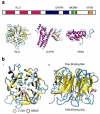Alsin and the molecular pathways of amyotrophic lateral sclerosis
- PMID: 17955197
- PMCID: PMC2364715
- DOI: 10.1007/s12035-007-0034-x
Alsin and the molecular pathways of amyotrophic lateral sclerosis
Abstract
Autosomal recessive mutations in the ALS2 gene lead to a clinical spectrum of motor dysfunction including juvenile onset amyotrophic lateral sclerosis (ALS2), primary lateral sclerosis, and hereditary spastic paraplegia. The 184-kDa alsin protein, encoded by the full-length ALS2 gene, contains three different guanine-nucleotide-exchange factor-like domains, which may play a role in the etiology of the disease. Multiple in vitro biochemical and cell biology assays suggest that alsin dysfunction affects endosome trafficking through a Rab5 small GTPase family-mediated mechanism. Four ALS2-deficient mouse models have been generated by different groups and used to study the behavioral and pathological impact of alsin deficiency. These mouse models largely fail to recapitulate hallmarks of motor neuron disease, but the subtle deficits that are observed in behavior and pathology have aided in our understanding of the relationship between alsin and motor dysfunction. In this review, we summarize recent clinical and molecular reports regarding alsin and attempt to place these results within the larger context of motor neuron disease.
Figures

Similar articles
-
ALS2/alsin knockout mice and motor neuron diseases.Neurodegener Dis. 2008;5(6):359-66. doi: 10.1159/000151295. Epub 2008 Aug 20. Neurodegener Dis. 2008. PMID: 18714162 Free PMC article. Review.
-
The first ALS2 missense mutation associated with JPLS reveals new aspects of alsin biological function.Brain. 2006 Jul;129(Pt 7):1710-9. doi: 10.1093/brain/awl104. Epub 2006 May 2. Brain. 2006. PMID: 16670179
-
Infantile-onset ascending hereditary spastic paraplegia with bulbar involvement due to the novel ALS2 mutation c.2761C>T.Gene. 2014 Feb 15;536(1):217-20. doi: 10.1016/j.gene.2013.11.043. Epub 2013 Dec 4. Gene. 2014. PMID: 24315819
-
Genotype-phenotype correlation in seven motor neuron disease families with novel ALS2 mutations.Am J Med Genet A. 2021 Feb;185(2):344-354. doi: 10.1002/ajmg.a.61951. Epub 2020 Nov 5. Am J Med Genet A. 2021. PMID: 33155358
-
Molecular and cellular function of ALS2/alsin: implication of membrane dynamics in neuronal development and degeneration.Neurochem Int. 2007 Jul-Sep;51(2-4):74-84. doi: 10.1016/j.neuint.2007.04.010. Epub 2007 May 4. Neurochem Int. 2007. PMID: 17566607 Review.
Cited by
-
A Case for Microtubule Vulnerability in Amyotrophic Lateral Sclerosis: Altered Dynamics During Disease.Front Cell Neurosci. 2016 Sep 13;10:204. doi: 10.3389/fncel.2016.00204. eCollection 2016. Front Cell Neurosci. 2016. PMID: 27679561 Free PMC article. Review.
-
Drosophila melanogaster as a Tool for Amyotrophic Lateral Sclerosis Research.J Dev Biol. 2022 Aug 30;10(3):36. doi: 10.3390/jdb10030036. J Dev Biol. 2022. PMID: 36135369 Free PMC article. Review.
-
Amyotrophic Lateral Sclerosis and its Mimics/Variants: A Comprehensive Review.J Clin Imaging Sci. 2018 Dec 6;8:53. doi: 10.4103/jcis.JCIS_40_18. eCollection 2018. J Clin Imaging Sci. 2018. PMID: 30652056 Free PMC article. Review.
-
ALS2-Related Motor Neuron Diseases: From Symptoms to Molecules.Biology (Basel). 2022 Jan 5;11(1):77. doi: 10.3390/biology11010077. Biology (Basel). 2022. PMID: 35053075 Free PMC article. Review.
-
Autophagy Dysfunction in ALS: from Transport to Protein Degradation.J Mol Neurosci. 2022 Jul;72(7):1456-1481. doi: 10.1007/s12031-022-02029-3. Epub 2022 Jun 16. J Mol Neurosci. 2022. PMID: 35708843 Free PMC article. Review.
References
-
- Cleveland DW, Rothstein JD. From Charcot to Lou Gehrig: deciphering selective motor neuron death in ALS. Nat Rev Neurosci. 2001;2:806–819. - PubMed
-
- Bruijn LI, Miller TM, Cleveland DW. Unraveling the mechanisms involved in motor neuron degeneration in ALS. Annu Rev Neurosci. 2004;27:723–749. - PubMed
-
- Siddique T, Lalani I. Genetic aspects of amyotrophic lateral sclerosis. Adv Neurol. 2002;88:21–32. - PubMed
-
- Rosen DR. Mutations in Cu/Zn superoxide dismutase gene are associated with familial amyotrophic lateral sclerosis. Nature. 1993;364:362. - PubMed
-
- Hadano S, Hand CK, Osuga H, Yanagisawa Y, Otomo A, Devon RS, Miyamoto N, Showguchi-Miyata J, Okada Y, Singaraja R, Figlewicz DA, Kwiatkowski T, Hosler BA, Sagie T, Skaug J, Nasir J, Brown RH, Jr., Scherer SW, Rouleau GA, Hayden MR, Ikeda JE. A gene encoding a putative GTPase regulator is mutated in familial amyotrophic lateral sclerosis 2. Nat Genet. 2001;29:166–173. - PubMed
Publication types
MeSH terms
Substances
Grants and funding
LinkOut - more resources
Full Text Sources
Other Literature Sources

